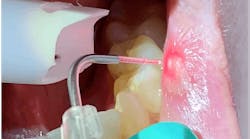Research correlates performance of American dental practices with U.S. recession and recovery
In an effort to "keep our industries aware of economic behavior relevant to them," according to Vijay Sikka, CEO of Sikka Software, the company released its latest white paper, the Sikka National Dental Economic Report, this week. The research, which is written by Mr. Sikka, offers an in-depth, year-over-year analysis of the recession, transition, and recovery of the American economy from 2008 to 2014 through the lens of the U.S. dental industry.
"Knowledge is power, and is the basis for measurement and comparison," Mr. Sikka said. "We publish these statistics to serve the markets we're directly in, but we also publish this data for more broad range comparison of economic measurement, allowing any consumer of our data to map the behavior in our specific health-care space to other economic data segments."
The latest data has led Mr. Sikka to conclude that dental practices are facing a continuing economic slowdown. "When looking at the full data set represented within this white paper, we're seeing a solid decreased trend from 2007 through 2014. The proof is within the data, and based on our increased opt-in customer base over the past few years, we add deeper credibility to these trends and the data we've presented. Said plainly, we predict an economic slowdown based on what we've seen over the past several years from a data perspective, paired with the significant number of practices that data represents."
Analyzing real-time benchmarking data from more than 12,500 solo and group U.S. dental practices, Sikka found that their performance closely mirrored macroeconomic indicators, including a recent transition period between downturn and recovery. The whitepaper illustrates trends from hundreds of key performance indicators from the past six years, including the following:
Doctors' net production
• In 2014, doctors spent 12% fewer working hours in their practices than they did during the peak number of hours worked in 2011, a transition period.
• Doctors’ average daily net production is trending downward in 2014 and did not show the usual surge in June.
Gross production per chair hour
• This is a "forward" indicator, as it shows how much successful scheduling and work is being done on patients.
• 2014 is trending worse than 2013.
Total indirect restorations to comprehensive exams
• Total indirect restorations are discretionary, often cash-driven treatments, and thus considered a forward indicator of consumer confidence.
• By that measure, 2014 is among the worst recovery years.
Implant services production by practice
• In 2014, 29% more implant procedures were done on average compared to 2010 and 2011.
Number of patient referrals
• In 2014, there were 26% more existing patient referrals compared to 2010, indicating increasing practice success in asking for referrals.
Cash vs. insurance patients
• In 2014, dentists saw more patients with insurance than in previous years, in line with stronger employment figures. Compared to 2010, the ratio of cash patients to insurance patients has dropped by 34%.
• In 2014, cash patients to insurance patients decreased by 12% as compared to 2013.
Comprehensive exams
• During the recession, practices did more comprehensive exams in order to identify more treatment opportunities, but production of practices was down.
• From 2013-14, the number of comprehensive exams dropped by 69% compared to 2010.
“This is the first research of its kind to be published in the dental industry,” said Mr. Sikka. "There are several factors that we've observed as contributing to decreased figures in 2014, and the primary behaviors are slow-to-pay patients and insurance companies, decreased doctor hours worked, and a decline in new patients and visits. Where these aspects are only a selection, they symbolize the lifeblood of a practice. These business, and revenue, critical declines are the core of what has resulted in decreased 2014 trends."
What steps does Mr. Sikka recommend dentists take to help get them through the slowdown? "We recommend that practices tune-in. In addition to the economic reporting we provide at a national level, this type of data is also available at the individual practice level. Practices can stay informed of the big picture by way of white papers and articles such as these. Also, applying this technology via Sikka apps, specifically Practice Optimizer and Patient Homepage, to their businesses is a great way to stay ahead. Sikka apps allow providers to understand where their practices are excelling or falling behind. This, paired with understanding things at a national level, allow businesses to implement real-time improvements, which allows for better patient care and an increased bottom line."
To download a copy of the economic white paper, visit the Sikka Software website. Sikka customers can access their own Success Reports after registering online.







